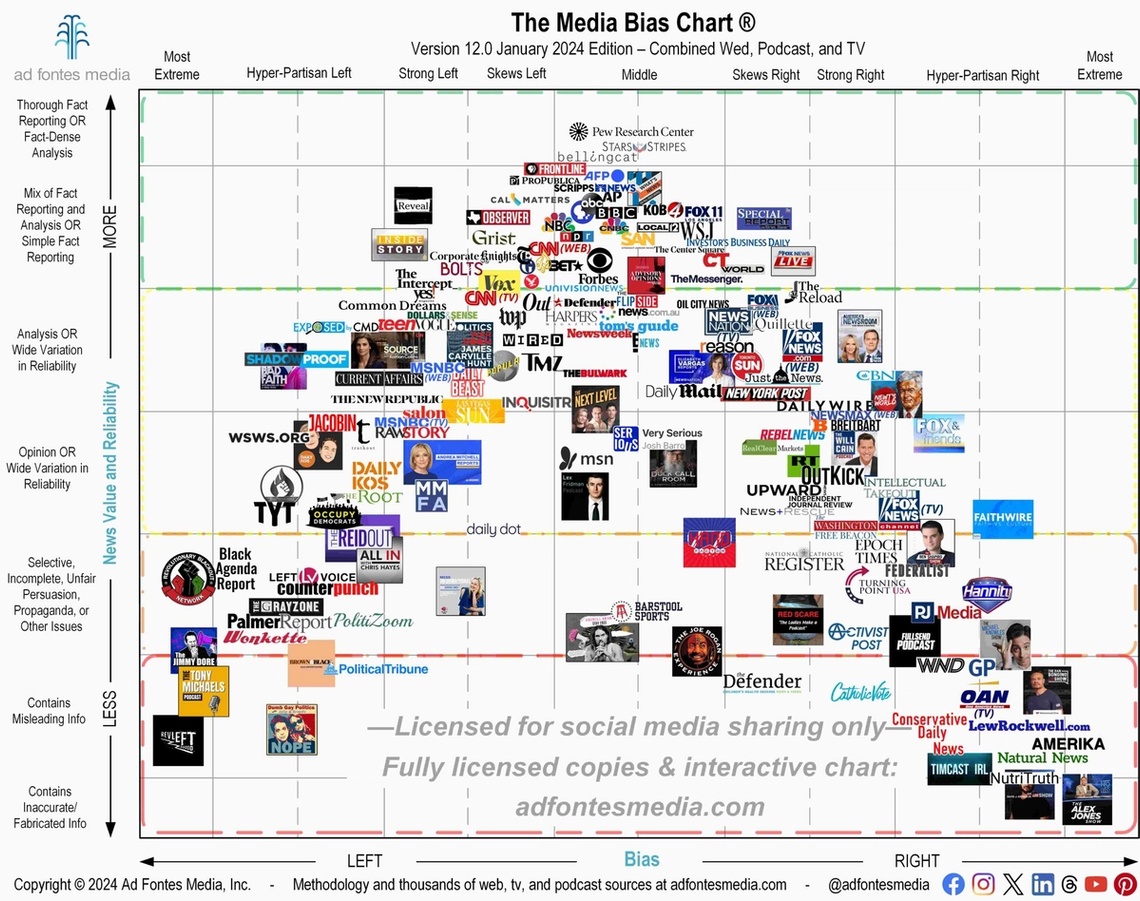✦ Marketing Ad Fontes Media Ad Fontes MediaAn ad tech company is launching a new platform with a mission of persuading advertisers to return to news, Max Tani reports. Ad Fontes Media told Semafor that earlier this month, it launched a partnership with The Trade Desk with the aim of directing more advertising dollars to news by proving to advertisers that quality journalism was where they can find the highest quality news advertising inventory. In a statement to Semafor, the company said it believed that the new capability inside the ad tech platform could help advertisers find the most reliable, unbiased news sources, which in turn could deliver higher returns than other advertising vertical. Ad Fontes Media is most well known for its media bias charts, which attempt to illustrate source reliability and political bias. The company said that it could help flagging advertising revenue for news media companies, which has declined significantly as Facebook and Google have gobbled up digital advertising dollars. In particular, the platform was designed to help advertisers find sites with reliable news and high advertising return categories, including sports, entertainment, and lifestyle news. “The Trade Desk believes in the power of trusted journalism and the role of advertising in funding it,” Samantha Jacobson, the company’s chief strategy officer, told Semafor. “We are pleased that our customers will now have access to Ad Fontes’ media ratings data so that they can have as much confidence as possible that they are advertising against premium journalism content.” “It’s never been more important to support responsible journalism and broad consumer access to trustworthy news and information. GroupM is committed to championing journalism through our Responsible Investment Framework and our Back to News Initiative. We applaud Ad Fontes Media and the Trade Desk for their work to support advertiser investment in news and reach high quality audiences in trustworthy environments.” Andrew Meaden, GroupM’s global head of investment, said.
Paid media: Biden’s re-election will depend on old-fashioned, and new-fangled, advertising. Our colleague Shelby Talcott took a look at what that paid media campaign will look like. ⁛ NewsCarlson in the Gulf: A source spotted Tucker Carlson at the “Tuscan bistro” Il Burro in Dubai’s Jumeirah Al Naseem hotel complex Thursday evening, evidently sticking around the media-investment friendly Emirates for a few days after a talk Monday. Modi’s “vice is tightening”: The veteran French correspondent Vanessa Dougnac left India after an expulsion threat. “With two months to go to the general elections, the vice is tightening on foreign correspondents,” says Reporters Without borders. Et tu, Ezra: Don’t underestimate the influence of the New York Times’s Ezra Klein, who used his platform last week to press named Biden advisers to suggest he not seek re-election. Klein cites the same things we’ve noticed here: That Biden can’t seem to manage some campaign basics. He also saw declining the Super Bowl interview as a particular red flag. Keep it in the group chat: The New York Times deleted internal Slack messages critical of a recent column on detransitioners with a note that says criticizing colleagues and coverage on Slack violates HR policies, a rule it’s also been applying to Gaza coverage. A post reminding staff in the “Times Out” group Slack of that rule got 19 thumbs down emojis, the last redoubt of Slack dissent. ✰ HollywoodIt’s all happening: The shotgun wedding media mergers that everyone anticipates and nobody is excited about are continuing apace: Who isn’t excited for Paramount Peacock Plus?? The business of LeBron: A tidbit from Jessica Toonkel’s profile of the superstar and his much-imitated production company, Springhill: “The majority of SpringHill’s roughly $200 million in revenue comes from its studio business and advertisers hiring the company to create sponsored short videos meant to be shared on social media.” Redbird rollup: The Emirates-funded, Jeff Zucker-led Redbird IMI picked up the largest TV producer in the UK. ⁜ TechDead to Musk: That’s Matt Taibbi, who was the billionaire’s favorite journalist until he chose to stay on Substack instead of switching to an X subscription product. Reddit.ai: The last good social platform, which is a public company despite feeling like an eccentric community, sold the rights to training data to an undisclosed AI partner for $60 million ahead of a planned IPO, a move that will help set market prices for huge bodies of text. Robots RIP: The age of AI is sapping the power of the great hex of the search era, robots.txt. Only The Verge would nerd out on this topic with this much gusto. ⁋ PublishingNot science fiction: The organizers of the Hugo Awards vetted nominees for writing, or social media posts, of a “sensitive political nature” that might offend the awards’ Chinese hosts. | 







